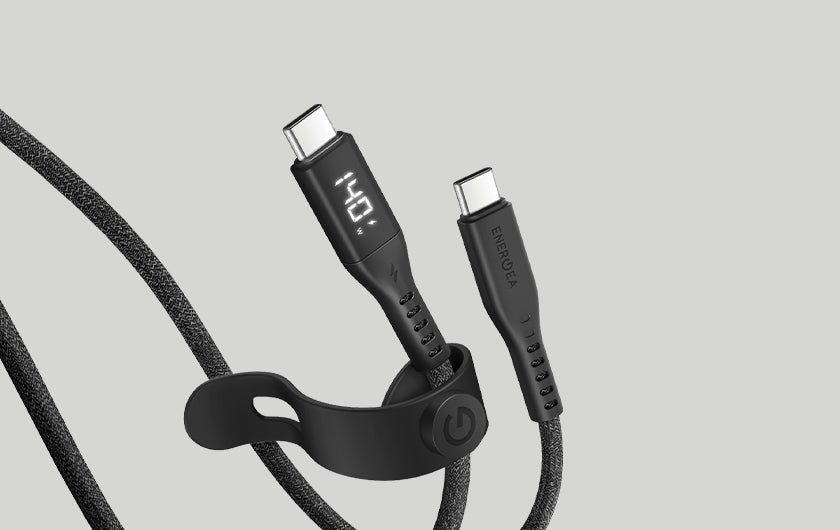With the news that Apple’s latest iPhone models (from iPhone 15 onwards) will adopt the USB-C port used by other manufacturers, consumers globally can rest easy knowing that Apple's latest devices are compatible with their USB-C adapters.
Nevertheless, those still using older models may require a different type of charging cable, as the older gadgets from various brands often do not utilise the same USB port. Therefore, it is vital for this group of people to know which one will work with their mobile phones.
This article will provide you with the information you are looking for regarding the various charging cables available on the market and which devices they are compatible with.
The Common Types of Charging Cables
1. USB-C
USB type C charging cables are now the de-facto charging cables utilised by smartphone manufacturers globally. Even Apple is jumping on board with its iPhone 15 models. That is no surprise, as it offers various advantages compared to its predecessors, allowing for faster charging and data transferring than previous generations of charging cables.
Another advantage of a USB-C cable is its adaptability. Users can plug in the charging cable in whichever direction they desire, and it will function normally. So, gone are the days when you have to struggle to insert the charging cable into the port.
If your smartphone was made from 2015 onwards, it should be compatible with a USB-C charging cable. With that said, we still recommend checking the compatibility of your model or enquiring with the vendor before purchasing a brand-new USB-C charging cable.
Examples of devices compatible with USB-C:
- Samsung Galaxy S8, Note8, A10, and above
- Newer generations of Samsung Galaxy Tablets
- iPhone 15 and above
- Google Pixel series
- Newer generations of iPads
2. Lightning cable
Your smartphone likely uses a lightning charging cable if you are an Apple user unless you have the latest iPhone 15 model. That is because Apple adapted the lightning connector in its various devices – from MacBooks and iPads to iPhones – after 2012, with a few exceptions.
The benefit of this change is that users can utilise a single cord to connect most of the Apple products they own, with the exception of newer iPads using USB-C and Apple watches, since they all use lightning cables. Currently, lightning cables are available in USB-A and USB-C formats.
Examples of devices compatible with lightning cables:
- iPhone 5 series
- iPhone 6 series
- iPhone 7 series
- iPhone 8 series
- iPhone SE
- iPhone X series
- iPad 4 series
- iPad mini, iPad mini 2, 3, and 4
- iPod nano 5th, 6th, and, 7th generation
USB-C lightning cables allow users to charge Apple products using a USB-C adapter. By connecting the USB-C lighting cable to a USB-C port, you can power and sync your AirPods, iPad, and iPhone. Some may prefer this charging cable, as specific iPhone models charge faster when connected to a USB-C adapter with the USB-C to lightning cable.
Examples of devices compatible with USB-C to Lightning Cable:
- iPhone X series
- iPhone 11 series
- iPhone 12 series
- iPhone 13 series
- iPhone 14 series
USB-C Vs. Lightning Cables: What Are The Differences?

The most obvious difference between USB-C and lightning format is the list of devices each charging cable supports. Lightning cables primarily function with Apple devices, whereas USB-C connectors have a universal utility. Of course, Apple is now making the shift to USB-C charging cables with its newer generations of iPad and the iPhone 15.
Nevertheless, those with older Apple smartphones or tablets can purchase converters that make lightning connections compatible with USB-C and vice versa for use with their devices. Most prefer to do this due to the superior data transfer speed and charging power offered by USB-C charging cables.
For instance, the latest USB-C cables (USB 4.0) support data transfer speeds up to 40 Gbps (gigabits per second) and offer up to 240W of charging power. The output depends on the fast-charging threshold of the device in question, with the charging cable regulating the amount of power to match the connected devices.
Conversely, lightning cords manage only a data transfer rate of 480 Mbps (megabits per second), falling in line with the USB 2.0 standard. There are exceptions to this, with specific hardware, like the 12.9-inch iPad Pro (1st and 2nd generation) and 10.5-inch iPad Pro, supporting data transfer speed of up to 5Gbps. As for charging, lightning connectors support up to 20W of output, which is sufficient to provide half a charge to an iPhone in as little as 30 minutes.
Purchasing a compatible charging cable for your device is essential if you wish to charge or transfer data to and from your phone or tablet quickly. So, ensure you choose the one that best suits your gadget’s requirements. Fortunately, you need not search far for your ideal fast-charge cable. At Energea, we offer a comprehensive catalogue of charging cables. Visit our website today to browse our range of products.


